taken from the on-site information board:
Death sites of our ancestors
In front of us are boulders of a stone burial chamber, which were recovered from a burial mound about 200 m east in the Stiftungsland Schäferhaus. Archaeologists reconstructed the original position of the stones: The stone chamber was rectangular in plan. Their upright standing boulders were covered with a large rock slab. On one narrow side was an entrance through which the dead were brought into the chamber.
During the excavations of the burial mound “Rovhøj”, the archeologists discovered pottery shards and tools made of fire and flint stone in this burial chamber. They were laid in the tomb together with the dead.
A look back:
After the ice age, the landscape in Schleswig-Holstein and Jutland was barren – the people lived from hunting and gathering. They followed the migration behavior of the hunting animals and the supply of plant food. This unsteady way of life is typical of the Paleolithic. In the period from about 8,000 BC the climate warmed up, and plants and animals thrived in Schleswig-Holstein. As a result of the improved Paleolithic diet, e.g. through hunting and fishing people were already relatively stationary. The epoch lasted until the end of the fifth millennium BC and is called Mesolithic.
With the Neolithic approximately 4.300 to 2.300 BC the sedentary lifestyle spread. Food was no longer just collected or hunted, but consciously produced. The people now cleared parts of the forest and farmed, kept livestock and lived in sturdy wooden houses.
The craftsmanship reached a climax (stone processing, weapons and tool making, pottery). Due to a special vessel shape, a section of this period is referred to as “funnel beaker culture”.
From about the middle of the 4th millennium BC, the “funnel beaker people” built large burial mounds for their deceased with stone chambers, which they repeatedly occupied with funerals. These megalithic tombs were once found in thousands in northern Europe. There are two different types of megalithic chambers today: “Dolmen” (Breton stone table), with about 2 m² of interior space, or the larger “passage graves” with up to 12 m long burial chambers.
In the popular name “Hünengrab” (Hüne = giant) ideas are expressed that megalithic tombs were built by giants.





















